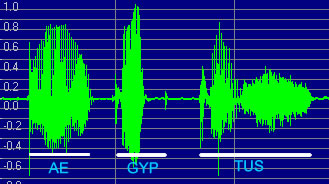Telling apart a syllable
A word is made up of one or more syllables, and a syllable is a basic unit for pronunciation, there's short period of time between sibling syllables. Look at this graph of the pronunciation of Aegyptus, how many parts(syllables) can you see?

Sound wave graph for Aegyptus
It's very easy to tell there're 3 syllables in this word in the graph: AE-GYP-TUS. But how to divide a word into syllables without the help of a graph? Counting syllables is easy, just find in the word how many vowels are there. Note that a diphthong acts as one vowel despite the fact that they're made up of two vowel letters.
Again, let's take Aegyptus for example. "ae" is a diphthong, y a vowel here and an u which is vowel too. So there're 3 syllables in the word.
Here's how to decide what each syllable should look like:
- The vowel-only syllable
- This kind of syllable is made up of only a vowel or diphthong, just like "AE" in Aegyptus. The vowel or diphthong itself is considerred a stand-alone syllable if: 1. No consonant preceeds it; and 2. No consonant after it; or 3. the consonants after it is not enough to allocate for the current syllable and the one follows.
For example, there's a "g" after "AE", but it is first allocated to the second syllable, thus g doesn't belong to AE, but "gyp". In the second syllable, there are two consonants after the vowel "y", it's enough for both syllables, thus "pt" is divided. - Consonant + Vowel syllable
- Such as [bonus] bonus. Take care not to pronounce it as [bonnus] ("dividing the only n into 2") as if it's spelled bonnus.
- Vowel + Consonant syllable
- Nothing difficult here, just say it clearly. eg. ad.
- Consonant + Vowel + Consonant syllable
- eg. dic
Two sibling consonants in any of the following case should not be divided to different syllables:
- Fixed consonant combinations, such as th, ph, sc etc.
- consonant + r/l, such as bra, cla etc.
At last, take care to distinguish the two identical sibling consonants, always pronounce each of them, or you may get yoursef embarrased. For example, annus means year, and is pronounced like [annus], if you forget to pronouce one "n", it would sound like "anus", which has the same meaning in English.
Accent
The classical and ecclesiastical use the same set of accenting rules. Some basic rules for Latin accenting:
- The accent is never at the last syllable as in French.
- Usually at the penultimate syllable.
eg. amā're. - If the vowel of the penultimate syllable is short, move the accent to the reciprocal 3rd syllable no matter the 3rd is short or not.
eg. ange'lĭcus, coelĭcus - For two-syllable words, at the first syllable (actually the penultimate) .
eg. Cae'sar , ca'nis - Certain little words called enclitics, which cannot stand alone, sometimes are added to and pronouced with the preceeding word. The most common are -que (and);-ve (or); -ne (the question sign). The syllable before the enclitics (that is, the last syllable of the original word) gets the accent regardless of its quantity.
eg. angelicus'que (Compare to it original form: ange'lĭcus)
There're many endings in Latin have fixed long or short penultimate vowels, which should be memorized together with declensions and conjugations. Here're some common endings:
| Long endings | Short endings | ||
|---|---|---|---|
| Ending | Examples | Ending | Examples |
| -ālis, -āle, -ālum | digita'lis, latera'le, barbita'lum | -ĭlis, -ĭle | vegeta'bĭle, invisi'bĭle |
| -ātus, -āta, -ātum | rotunda'tus | -ĭcus,-ĭca, -ĭcum | ellip'tĭcus, hemocy'clĭcus |
| -ōsus, -ōsa, -ōsum | globō'sus, tomentō'sa | -ĭdus,-ĭda,-ĭdum | ma'dĭdus |
| -īnus, -īna, -īnum | velutī'nus, vagī'num, aspirī'num | -ĭmus,-ĭma,-ĭmum | in'fĭmus, ma'xĭmus, mi'nĭmus |
| -īvus, -īva, -īvum | adhaesī'vum | -ŭlus, -ŭla, -ŭlum | gol'bŭlus, cap'sŭla |
| -ūrus, -ūra, -ūrum | matū'rus | ||
Finally, if you're not sure how to accent a word, just look it up in a dictionary ^-^.
